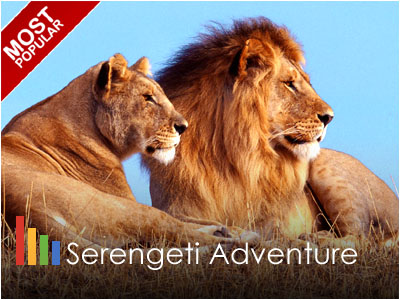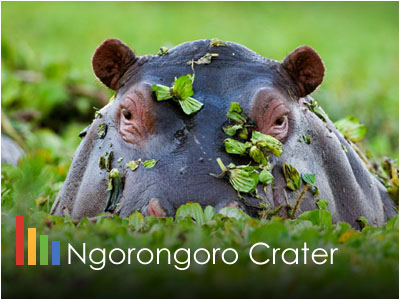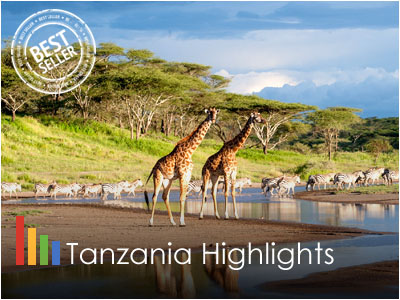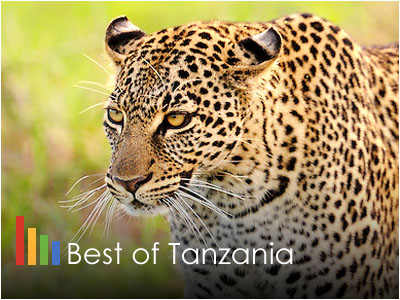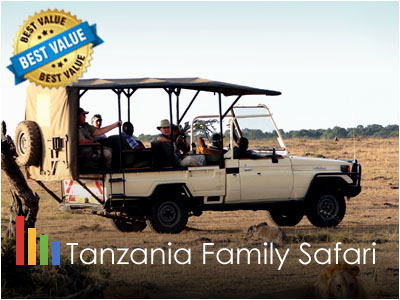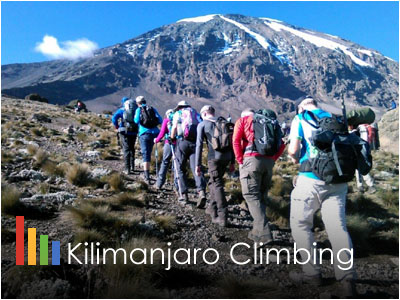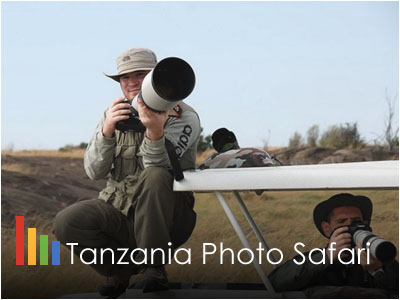Ngorongoro Conservation Area, Tanzania, Africa
Ngorongoro Conservation Area - Tanzania, Africa
The Ngorongoro Crater and Conservancy is a wildlife haven and, as such, well visited but it is virtually a ‘must’ on any first visit to Tanzania. A breathtaking sight, and an extraordinary place, the unique appeal of the Ngorongoro Crater is the sheer abundance of wildlife permanently resident on the crater floor. Lions stalk the grasslands in search of vulnerable game; flamingos grace the shallow lakes, and yet the Masai still bring their cattle down into the crater to graze alongside huge herds of wildebeest, zebra and buffalo as they always have done. Ngorongoro is a truly fascinating and unusual Conservation Area which includes the mystery of the Ngorongoro Crater at its centre, and then extends through the Crater Highlands, in which local tribes are permitted to maintain their traditional lifestyles in as natural environment as possible. This extraordinary volcanic landscape is rich and fertile, with stunning craters and lakes, and the high altitude creates a malaria-free micro climate.
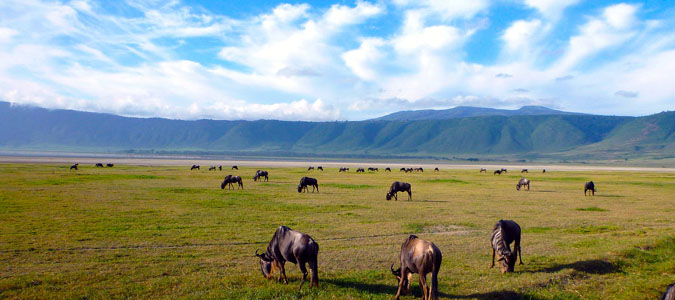
Basic Facts - Ngorongoro Conservation Area
The Ngorongoro Conservation Area is a protected area and a World Heritage Site located 180 km (110 mi) west of Arusha in the Crater Highlands area of Tanzania. The area is named after Ngorongoro Crater, a large volcanic caldera within the area. Ngorongoro is the largest un flooded and unbroken caldera in the world about 20kms across, 600 meters deep and 300 sq kms in area. The conservation area is administered by the Ngorongoro Conservation Area Authority, an arm of the Tanzanian government, and its boundaries follow the boundary of the Ngorongoro Division of the Arusha Region..
More About Ngorongoro Conservation Area
Three million years ago, there slumbered a massive supervolcano in what we now call Northern Tanzania. The mountain stood higher and mightier than nearby Mount Kilimanjaro. Its summit scraped the ceiling of Africa and its slopes were so vast they directed their own weather patterns and water flow. All was well with this sleeping sentinel until one day the mountain woke up. Then it fell down. The volcano erupted with a blast so ferocious that it caved in on itself, an implosion creating a caldera spanning a hundred square miles: 12 miles wide and 2,000 feet deep. What had once claimed the highest peak on the continent was now a mere impression, inverse to its former glory. But the glory returned. Over the course of a few million years this geologic divot filled with life. First, it caught pockets of fresh water. Second, lush vegetation developed, and third—you guessed it—the wild ones arrived. Abundant water and grasses attracted ungulates, large predators, and countless bird species. Because of its enclosed topography, animals would descend into this bowl-shaped place and never leave. This was where the party was. Over time the caldera teemed with sustenance, while also providing grazing lands for human tribes living along its edge. And so began the story of one of our planet’s most beautiful places, an unprecedented coliseum of biodiversity. Welcome to the Ngorongoro Crater!.
Now classed as a UNESCO World Heritage Site, the Ngorongoro Crater was formed when a giant volcano exploded and collapsed around 3 million years ago. The cone of the volcanic caldera collapsed inwards and created what we know today as one of the most unique safari parks in Africa, and indeed the world. A one of a kind safari destination teeming with life. In 1951, the enormous Serengeti National Park was declared, encompassing the present Serengeti, plus the Ngorongoro area and surrounding Crater Highlands. Today, this is split into the present-day Serengeti National Park, and the current Ngorongoro Conservation Area. The conservation area now encompasses a large area of the short-grass plains on the southern side of the Serengeti Plain and also the Ngorongoro Highlands, a range of largely extinct ancient volcanoes on the west side of the Great Rift Valley. For more information regarding tours and safaris to Ngorongoro Conservation Area, please DO NOT hesitate to Contact Us.
Today, Ngorongoro's caldera shelters the most beautiful wildlife haven on earth. The rich pasture and permanent water of the Crater floor supports a resident population of some 20,000 to 25,000 large mammals. They are not confined by the Crater walls, and can leave freely; they stay because conditions are favourable. Since most of the Crater floor is grassland, grazing animals predominate: gnu, zebra, gazelles, buffalo, eland and kongoni (Coke's hartebeest) and warthogs. The swamp and forest provide additional resources for hippos, some of Tanzania's last remaining black rhinos, giant-tusked elephants, waterbucks, reedbucks and bushbucks, baboons and vervets. The steep inner slopes provide a habitat for dikdiks and the rare mountain reedbuck. Towering euphorbias cling to the crater walls and on the floor, Fever tree and Fig tree forests give shade to an awe-inspiring array of creatures. All these animals in turn support large predators such as Lion and Leopard, and scavengers such as Hyena and Jackals. For the best viewing and photography, approach the animals slowly and quietly and stay on the official tracks.
What you can see of birdlife depends greatly on the season of the year, because there are resident birds and migrant birds. You are certain to see many residents, like ostriches, bustards and plovers all year round. In wet season they share the Crater with European migrants such as White Storks, Yellow Wagtails, swallows, etc. The migrants pass through from November through May, coinciding with the rains in Africa and the winter in Eurasia. There are also local migrants such as flamingos, storks and ducks which come and go depending on the state of the lake and ponds. Other birds you can see are Stonechat, Anteater Chat, Schalow's Wheatear, Fiscal Shrike. Augur Buzzards, Verreaux's Eagle and other raptors live in the Crater.
Ngorongoro safari lodges are situated on the rim of the crater, which is 2,235 metres (7,264 feet) above sea level. It can get quite fresh up here, and gets very cold at night in the winter months of June to August, but is opposingly hot down in the crater during the day. The Crater rim touches swathes of clouds for most days of the year, with cool high altitude vapours that seem to bring a clean lightness to the air, and also a chill. These highlands wake up to a misty fog in most months, other than the high dry season during December and January. The weather is usually dry from June to November. July is the coldest month and highland temperatures may fall below freezing. It rains anytime from November to May, with the longer rains in April to May. The amount and pattern of rainfall varies and a dry period in January and February may split the rainy season into short and long rains. The forested eastern slopes get much more rain due to their elevation than the arid country to the west. The rain arrives in stormy showers usually during afternoons and nights, which cleanses the air to reveal clear, beautiful views of the floor below as the day progresses.
The Ngorongoro crater and wider conservation area is easily accessible. There is a daily light aircraft flight to Arusha from Dar (other airstrips in Tanzania also fly to Arusha) where you would then be met by a safari guide in a close-sided pop-top 4 x 4 safari vehicle. Your guide will stay with you for your time down in the Crater, and possibly longer. The drive from Arusha is around 4 hours to begin an Ngorongoro Crater safari. Another alternative is to fly to Manyara airstrip, which is about an hour from the Crater. Depending on where you’re staying – you may be met by the lodge, or picked up by a private driver guide. .
There is no accommodation within the Ngorongoro Crater and so generally speaking there are two different options; either staying on the Crater rim or on the Rift Valley Escarpment. There is a collection of lodges perched on the Crater rim overlooking the floor. These lodges tend to have incredible views and easy access to the crater, however the prices reflect this. The Ngorongoro Crater Lodge is the most luxurious option but it is also the most expensive. The other Lodges that have views of the Crater floor are the: Ngorongoro Serena Safari Lodge; Ngorongoro Wildlife Lodge; and the Ngorongoro Sopa Lodge. These lodges are much larger and also benefit from an exceptional view, however their size means they’re lacking in the character you can find elsewhere. There are a handful of other lodges and camps in the hills of the Crater, which do not have the views but are still extremely convenient and are also more affordable, an example of this is the Rhino Lodge.
AfriChoice operates a wide range of carefully designed tours and safaris to Ngorongoro Conservation Area by providing transport and booking a hotel for you. Our safari consultants will always be at your assistance should you need a tailor-made holiday to this unique destination. NB: For more information regarding Ngorongoro Conservation Area, DO NOT hesitate to Contact Us.
Contact Us for more information:
Tanzania Popular Wildlife Safaris
-
Serengeti Safari Adventure
Serengeti 3 Days Safari
-
Ngorongoro Crater Tour
Ngorongoro Crater Safari
-
Tanzania Highlights Safari
Tanzania Wildlife Safari
-
Best of Tanzania Safari
Best of Tanzania Safari
-
Tanzania Family Safari
Tanzania Family Safari
-
Mt. Kilimanjaro Climb
Mount Kilimanjaro Tanzania
-
Tanzania Photo Safari
Tanzania Wildlife Photo Safari
-
Tanzania Safari & Zanzibar
Tanzania Safari & Zanzibar Beach



 Paul Kitching - UK
Paul Kitching - UK Karen Howard - CANADA
Karen Howard - CANADA


